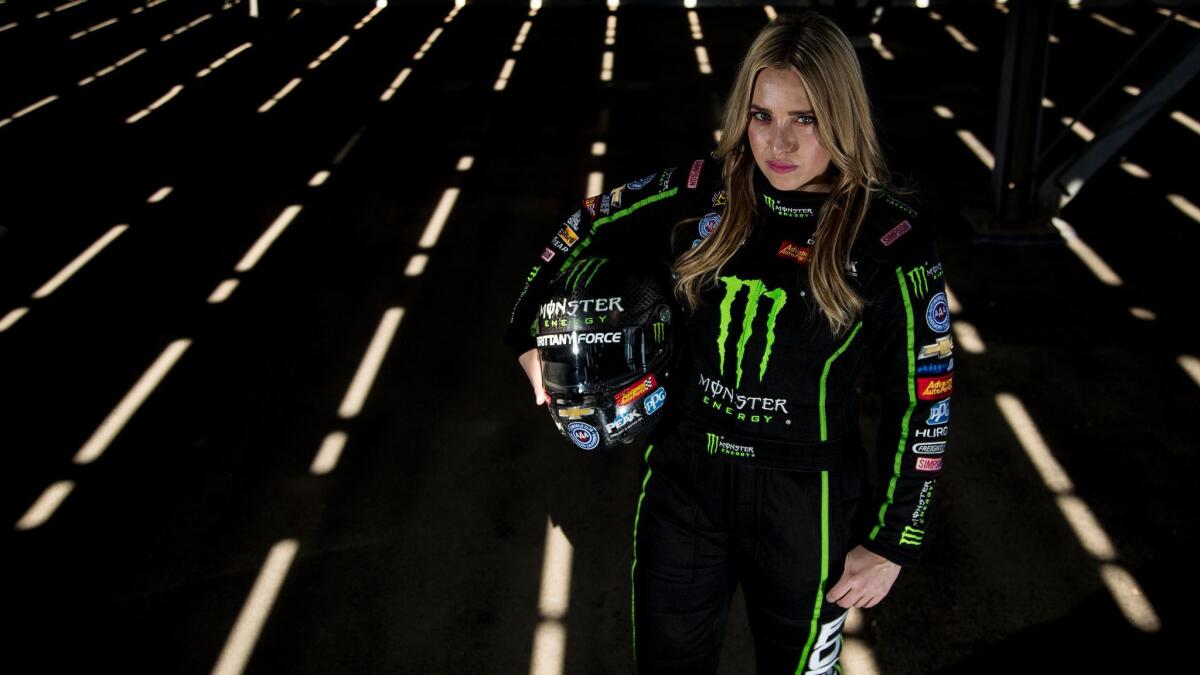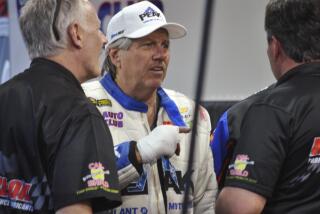In NHRA, women have traction in race against men

The cars are rockets on wheels, nitro fuel feeding flame-spewing 10,000-horsepower motors that generate six G-forces and speeds of more than 300 mph in a matter of seconds.
With thunderous engine roars and earsplitting tire squeals, drag racing literally screams machismo. Yet it is arguably the only mainstream sport in which women compete head-to-head with men and more than hold their own.
Leah Pritchett, 29, of Redlands will be out to defend her top-fuel title at the season-opening National Hot Rod Assn. Winternationals at Auto Club Raceway in Pomona beginning Thursday and running through Sunday. Also racing will be Erica Enders, 34, of Houston, who won pro stock world titles in 2014 and 2015; and the Force sisters, Brittany, 31, and Courtney, 29, of Yorba Linda. Brittany was world champion in top fuel last season, and Courtney finished third in the funny car standings.
“I’m not going to say women are absolutely dominating this sport; none of us would have the success we’re having without the males who believed in us,” Pritchett said. “But we knew we could do it if we had the opportunity.”
Top competitors display quick reflexes and exceptional hand-eye coordination, vision, focus and courage in holding a 330-mph top-fuel dragster or funny car straight down a 1,000-foot strip, or a 213-mph pro stock car along a quarter-mile path.
Most races are won at the start, where drivers must expertly time a descending lighting column — called a Christmas tree — to beat their opponent off the line.
Though a certain amount of athleticism is required, drivers need not have the physique and strength of an NFL linebacker, the height and leaping ability of an NBA forward or the acrobatic versatility of a Premier League midfielder.
“Honestly, the car doesn’t know if you’re male or female,” said Brittany Force, the daughter of 16-time NHRA funny car world champion John Force. “That’s what it really comes down to.”
Dr. Vernon Williams, a sports neurologist at the Kerlan-Jobe Institute in Los Angeles, said studies suggest that men “in general” have slightly faster visual and auditory reaction times than women, but the differences are negligible and can be mitigated by other factors pertaining to the sport.
“It’s not like football or basketball or soccer, where there is going to be significant physical advantage in most situations for men,” Williams said. “When you’re talking about neurological contributions to performance like concentration, vision, reaction time, speed of mental processing, you wouldn’t expect there to be as much of an advantage as there is from physical contributions … like strength or height or power.”
Women actually have a physical advantage in the top-fuel class, where 33-foot-long dragsters must weigh a minimum of 2,330 pounds, including the driver. Because women typically weigh 20 to 50 pounds less than men, they can move specialty weights around the car — usually over the back wheels for better traction on hotter, slicker tracks and in the front to prevent wheelies that slow the car.
Pritchett, who is 5 feet 9, 130 pounds, said she has lost 15 pounds since the end of last season in hopes of maximizing that favor.
“If a 200-pound guy is driving, he doesn’t have any extra weight to move around the car, whereas we do,” she said. “We can add more traction and more horsepower. That gives you better performance.”
There is no clutch in top-fuel dragsters and funny cars. Drivers don’t shift. They hit the throttle to start, steer the car down the track and engage the parachute.
A shorter wheelbase makes funny cars tougher to control than top-fuel dragsters, but with three decades of engineering advances, the cars are virtually automated.
“The truth is, the cars pretty much do it for you,” said Shirley Muldowney, 77, a trailblazer who won 18 NHRA national events. “You point it, steer it, gather it up, go through the motions, pull the chute when you’re supposed to, and if you can hold it together, you’re going to do OK.
“You just have to be on time, keep it in the groove, and hope no one comes into your lane, of course. The cars are nothing like what we … had to muscle.”
It took a memorable race against a female rival two years ago at Arizona’s Wild Horse Pass Motorsports Park for Pritchett to realize just how far women had advanced at the track. Pritchett and Brittany Force were about to stage the first all-female top-fuel final since 1982, when Muldowney defeated Lucille Lee in Columbus, Ohio.
Engines revved and the cars’ fat back tires smoked and shrieked as Pritchett and Force edged their sleek dragsters to the starting line. But inside the cockpit Pritchett was just becoming aware that, as the track announcer put it, history was being made.
“I didn’t even realize I was running against Brittany until we were in the staging lane,” said Pritchett, who beat Force with a 323.12-mph pass to win her first NHRA event. “As cool as it was, I was so much more in love with winning my first race than beating another female.
“I think that’s a testament to how much the femaleness of the sport is geared toward the competition… . It’s a novelty to everyone else out there, but it is not a novelty to us.”
Pritchett, whose father was a land-speed racer at Bonneville Salt Flats, began racing at age 8 and competed in seven amateur categories. She studied marketing and communications in an effort to cultivate investors and partners and spent several years on a funny car crew before getting her nitro license.
She drove six different cars for three different teams in 2016 before linking up with Don Schumacher Racing and completing her first full top-fuel season in 2017.
Though they grew up in the sport and had access to the world-class mechanics and crew chiefs of their famous father’s teams, Brittany and Courtney Force spent six years as teenagers driving alcohol-fuel and super comp dragsters before graduating in their early 20s to top-fuel cars.
Enders fell in love with racing as a little girl and often hung around Muldowney’s pit area in hopes of talking to or getting an autograph from the woman known as the First Lady of Drag Racing. She spent years on the junior dragster circuit before working her way up to the professional ranks.
“The reason you see females where they’re at is because we’ve literally worked our tails off and climbed the ladder,” Enders said. “All of us have paid our dues. I was given no breaks because of my gender and would not expect to have been.”
Their persistence earned the respect of male drivers.
“Leah and Erica have been racing since they were practically walking,” said Antron Brown, 41, a three-time top-fuel champion from New Jersey. “These women eat, sleep and dream about it. They have so much passion and drive. They come out here knowing they’ve put the work in, and they’re not intimidated.
The physical demands of her class provide a stiff challenge for Enders. Unlike top-fuel dragsters and funny cars, her bulkier pro stock car has a clutch and five-speed transmission that requires her to shift four times down the track.
“It takes a lot to drive these cars,” she said. “I’m steering with my left hand, shifting with my right hand, and pushing about 800 pounds of pressure in on that clutch pedal, so you have to have a leg on you. I’m right-hand dominant, so everything on my right side is bigger, except my left calf is huge compared to my right one, so it makes shopping for knee boots kind of hard.
“That’s a girl problem, I guess.”
It’s not the only “girl problem” female drivers endure. Enders said she has been “hit on” by men inside and around the sport and that “there’s still a slightly chauvinistic mentality out there, which comes with the territory when you’re a female in a male-dominated sport.”
Pritchett said she has “heard probably everything you can hear, but I’m probably too much of a pistol, so people have learned that stuff ain’t gonna fly.”
Enders and Pritchett and the Force sisters said they’ve never experienced anything that rises to the level of sexual misconduct. Around their crews, the women are, well, just one of the guys.
“My team owner has 19 employees, all men, so it’s me and 19 men on the road 300 days a year,” Enders said. “They’re like 19 brothers I didn’t necessarily want, and they make fun of me and pick on me.
“But the cool part is, they have my back 100%.”
It was different in Muldowney’s day.
“I had my battles with men,” said Muldowney, who started her career in the 1960s and raced for four decades. “They were terrible. They would throw X-rated toys in the seat of my car in the staging lane, anything they could think of. And I had a real temper back in the day. I would go after them. I got even at the starting line.”
Men in the sport appear to have evolved. When Brittany Force was test-driving top-fuel cars and contemplating a jump from alcohol-fuel in 2013, current rivals Morgan Lucas, Tony Schumacher and Shawn Langdon “went out of their way to encourage me to get into top fuel — they said they’d love to see a female in the sport,” she said.
Said Brown: “You don’t look at them as women. You look at them as racers.”
Perceptions from outside and the periphery of the sport may still be catching up.
“People think because we’re females that we need to be light and fluffy and really sweet,” Pritchett said. “I’ve had people from corporations to fans saying, ‘Wow, I wish there was a little more sweetness in your voice, maybe smile a little more,’ because that’s the image they want.
“But there’s been a shift away from being dainty. Strong is the new skinny.”
Twitter: @MikeDiGiovanna
More to Read
Go beyond the scoreboard
Get the latest on L.A.'s teams in the daily Sports Report newsletter.
You may occasionally receive promotional content from the Los Angeles Times.











